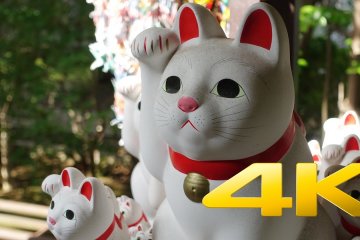
Les Maneki-neko du Temple Gotoku-ji
Gonzague Gay-BoucheryLe temple Gotoku-ji à Tokyo abrite de nombreux maneki-neko, des porte-bonheur en forme de chat apportant chance et prospérité.

Le temple Gotokuji est un temple bouddhiste de la période Edo, connu comme le berceau du chat porte-bonheur maneki neko. Situé à Setagaya, à Tokyo, le temple Gotokuji est un lieu populaire pour les amoureux des chats en raison de la présence de statuettes maneki neko autour du temple.
La légende raconte que Ii Naotaka a échappé à un orage inattendu au début du XVIIe siècle car il a été invité au temple par un chat. Pour montrer sa gratitude au chat, Naotaka a décidé de dédier le temple au clan Ii.
Le maneki neko est une figure célèbre au Japon. On le retrouve souvent à l'intérieur des magasins, avec sa patte levée en signe de bonne chance pour le propriétaire. Bien qu'il existe de nombreux types de figurines Maneki Neko, qui lèvent la patte droite ou gauche, au temple Gotokuji vous trouverez seulement la version de chat avec la patte droite levée.
Three minute walk east of Miyanosaka Station (Tokyu-Setagaya Line), which is a 10-minute train ride (6 stops) from Sangenjaya Station.

Le temple Gotoku-ji à Tokyo abrite de nombreux maneki-neko, des porte-bonheur en forme de chat apportant chance et prospérité.
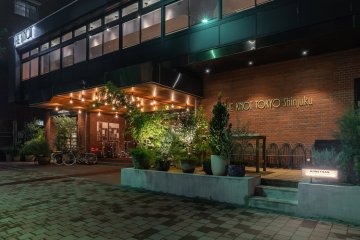
Situé à deux pas de l'immense parc central de Shinjuku, THE KNOT TOKYO Shinjuku est un hôtel moderne de caractère avec un accès facile à la gare de Shinjuku et au sanctuaire Meiji. Le bâtiment de l'hôtel de 14 étages a été rénové et rouvert sous le nom de THE KNOT TOKYO Shinjuku en août 2018. La conception de l'atrium spacieux offre une atmosphère détendue et relie le restaurant, le bar, le salon et le hall les uns aux autres. L'hôtel dispose de plus de 400 chambres et 7 types de chambres et au dernier étagent se trouvent des chambres de style occidental offrant une vue sur le parc ainsi qu'une suite avec terrasse récemment ouverte. L'un des points forts de THE KNOT est sa délicieuse cuisine. Vous y trouverez six zonesde restauration, proposant par exemple des grillades au thé noir de qualité ou du pain frais.

With Koenji being a "creative town" it's no surprise that the BnA Hotel opened there in 2016 and has had, subsequently, an incredible impact on the local community. BnA (Bed and Art) has other spaces dotted about Tokyo and Kyoto, but the Koenji edition is possibly more immersive as the concept is "stay in an artwork." In collaboration with local artists, the BnA has created an impressive multi-storey art experiment for art lovers and creatives with a desire to inhabit art. The first floor acts as a front desk and bar which comes alive at night with events and selected DJs. It also hosts Masu Masu onigiri cafe with artists being asked to come and exchange artwork with each other in a gesture which reflects the true spirit of Koenji. With two "living art" twin rooms taking up the second and third floors designed by a seasonal rotation of local artists, guests can engage with and inhabit their art rooms. BnA Koenji also plays host to a rooftop lounge and a basement space which is used for artists residencies where their work is shown to the public and a DJ booth and streaming equipment for live performances. With live painting events and an eclectic variety of regular events, the BnA Hotel becomes, itself, a living canvas. The BnA believes that it's a machigata hotel, meaning that guests should (and are encouraged) to interact with Koenji. Use the public sentos, eat in the local restaurants that surround the hotel and buy locally from the multitude of shops, market stalls, bars and cafes which make-up the fabric of Koenji. Feted by international press such as The Guardian, BnA acts as a creative network with the concept of serendipity being discussed as the bar becomes an ad hoc meeting place where collaborations and friendships between artists and locals are born. The BnA was also instrumental in a street art festival named MCP (Mural City Project) which was supported by Suginami Ward. MCP was incredibly ambitious and truly communal with the desire to transform and coalesce the community through the creation of public murals. The BnA, Koenji and Suginami spearheaded a public art movement which should be commended and replicated throughout Tokyo.
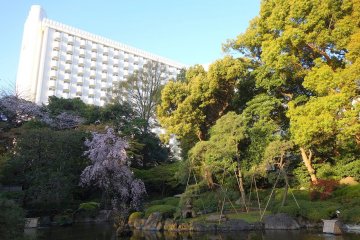
Just minutes from Shinagawa Station, the Grand Prince Hotel New Takanawa is surrounded by lush greenery in the Takanawa area, with rooms offering balcony views of the nearby gardens and the surrounding Tokyo cityscape. This urban resort features convention facilities like the Hiten banquet hall, the international Convention Center Pamir, as well as a wide variety of Japanese, Chinese and Western restaurants.

Mame Shiba Cafe offers a unique experience where you can interact with Shiba dogs while enjoying your favorite drinks. You cannot make reservations in advance through phone or online, so it is best to book early in the morning at a store. The cafe requires customers to make a reservation in-store, present their receipt at the reserved time, and then enter the cafe.

B-Flat Commune is an open-air hangout in Omotesandō featuring a variety of stalls and food trucks offering unique drinks, clothing, and bites to eat. Its relaxed vibe and plenty of seating make it an ideal spot for casual meetups and spending time with friends. It's a creative place where people can gather to eat a the open-air dining space or purchase fashion, antiques, product goods and other lifestyle items. Events are sometimes hosted at this community space, and operating stores may change from month to month.
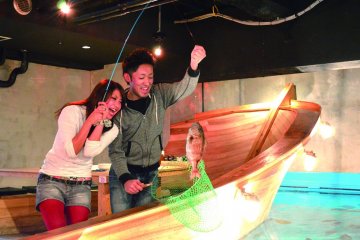
There is a restaurant right in front of the Meguro station where you can eat your own fish. All kinds of Japanese dishes and fresh seafood are also served. In some pools inside the restaurant you can catch your own fish with a fishing rod and net and then let the staff know which table it should be brought to. You can watch the fish being prepared in the kitchen and let you know in advance how the fish should be prepared: whether as sashimi, grilled, boiled, deep-fried (with tempura) or as sushi. If you don't manage to catch your own fish, then you can of course order a fish from the menu. However, the price is much lower if you want to have your own catch cooked .
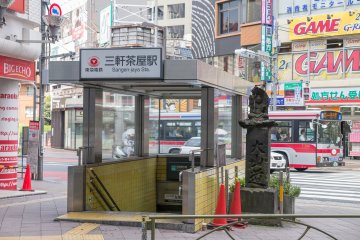
Sangenjaya est un quartier de l'arrondissement de Setagaya à Tokyo. Le nom Sangenjaya signifie "trois maisons de thé", bien qu'il soit simplement appelé "Sancha" par les habitants. Le quartier regorge de cafés chics et d'izakayas animés. Il est également connu pour son bâtiment Carrot Tower, haut de 27 étages, qui est ainsi nommé par les écoliers locaux en raison de sa couleur. La gare de Sangenjaya sur la ligne Tokyu Setagaya est située au premier étage. De plus, la zone a été l'inspiration pour divers endroits du jeu Persona 5. À proximité, à seulement 2 kilomètres, se trouve Shimokitazawa, un centre de culture et jeunesse, avec de nombreuses salles de mode, de théâtre et de musique le long de ses rues sinueuses. Si vous voulez vous immerger dans une culture liée à la mode à Tokyo, vous êtes au bon endroit.

Komazawa Olympic Park, located in both Meguro and Setagaya, Tokyo, is a sports facility built for the 1964 Summer Olympics. Approximately 90 percent of the park area is in the Setagaya district, while the remaining 10 percent is in the Meguro district At the beginning of the 20th century, the area served as a golf course, on which even Emperor Hirohito and King George V of England were invited to a game. The extensive grounds offer several sports facilities, including baseball fields, tennis courts, a swimming pool and a sports hall. There is also a stadium for 20,000 people, which is a venue for both soccer and American football games. There is also a very nice route that is ideal for jogging or cycling. [Photo: no_typographic_man / CC BY-NC-ND 2.0]

Since its opening in 2000 in the heart of Shibuya—Tokyo’s epicenter of youth culture, fashion, and music—WOMB has established itself as one of the most influential electronic music clubs in the world. Far more than just a nightlife venue, WOMB is a driving force behind Japan’s thriving club scene and a cultural landmark that bridges local talent with the global electronic music community. WOMB’s mission is clear: to deliver the freshest, most cutting-edge electronic music to fans in Tokyo and beyond. It regularly features international headliners while also championing the emerging sounds of Tokyo’s underground. The club’s main floor is renowned for its world-class sound system, immersive lighting, and striking laser visuals, offering a sensory-rich experience that rivals top clubs in cities like Berlin, London, and New York. But WOMB is more than just its main stage. The club features three additional sub-floors, each with its own identity and vibe, offering a wide range of electronic subgenres and giving up-and-coming Tokyo DJs and producers a platform to shine. This variety makes WOMB not only a destination for established names, but also a vital launchpad for local artists aspiring to gain international recognition. The club’s influence doesn’t stop at Tokyo’s borders. Through its global series, WOMB TOKYO NIGHT, the venue exports the energy and style of Tokyo nightlife to legendary venues around the world, including Fabric in London and Space Ibiza in Spain. These international events have helped position WOMB as a global ambassador for Japan’s club culture, attracting a loyal following of electronic music fans across continents. WOMB’s global reputation is further cemented by its accolades in Mixmag, the renowned UK music magazine. It was ranked the #2 nightclub in the world in 2005, #5 in 2008, and #4 in 2009—recognition that reflects its consistent innovation and influence in the global scene. Today, WOMB stands not only as a pillar of Tokyo’s nightlife, but as a cultural icon that blends the international with the local. It is a place where music, technology, and creative energy converge—a must-visit destination for any music lover seeking the true pulse of Tokyo’s dynamic electronic music landscape.